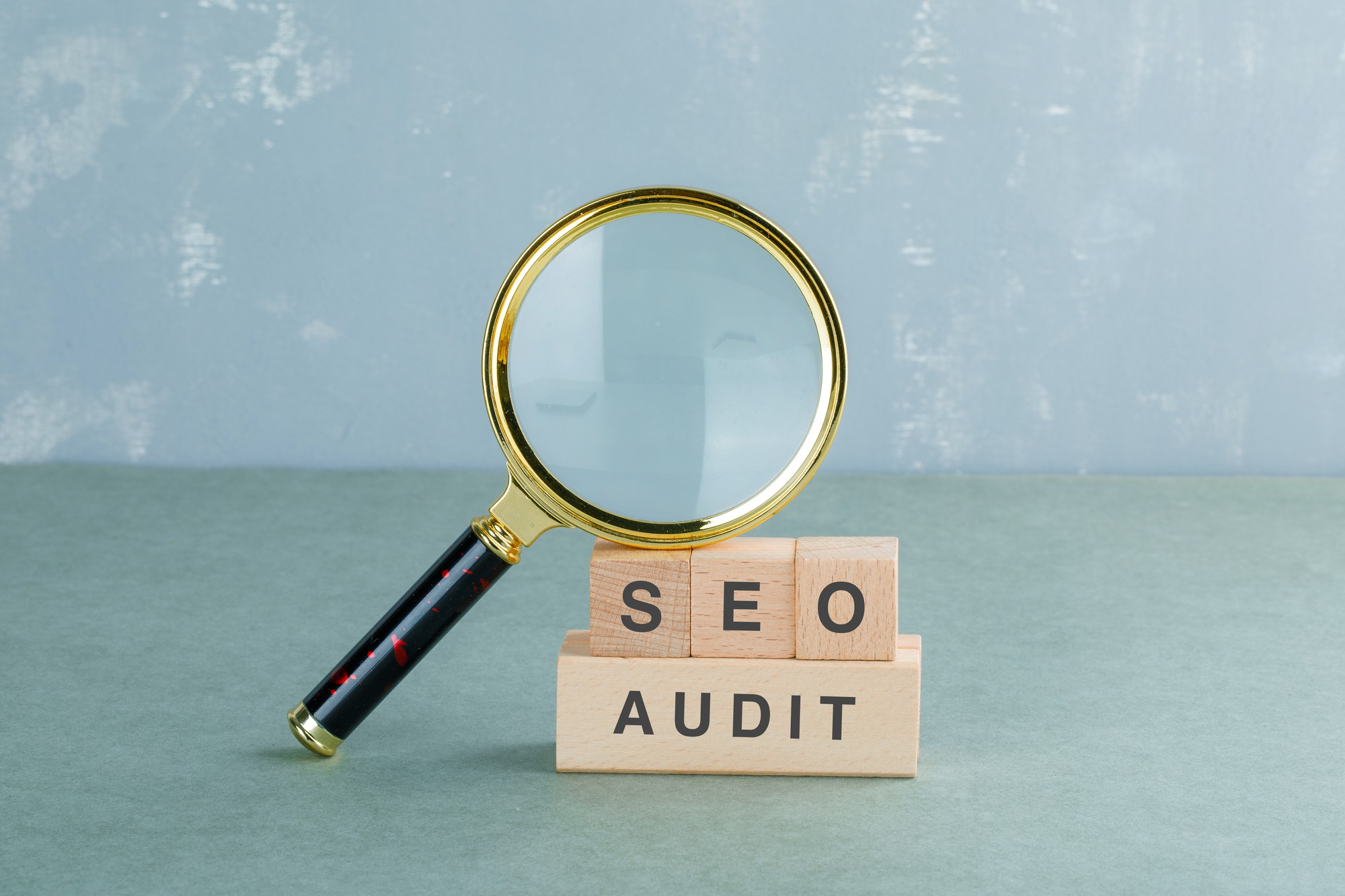Is SEO Dead?
Table of Contents
- SEO is Not Dead but Changing
- So What is Changing in SEO
- SEO Tactics That No Longer Work
- Building large numbers of poor-quality backlinks
- Obsessing over that number 1 ranking
- Over-optimising for focus keywords
- Focusing on optimising for search engines instead of people
- SEO Tactics That Do Work
- Develop your content for and target search intent
- Don’t forget about those long-tail keywords
- Generate good quality content then Promote, Promote and Promote again
- Optimise for Featured Placements
- Focus on the Long Term and make it Evergreen
- Shift from Keyword to Topic Research
- Refresh old content and promote it again
- Improve your CTR
- Perform regular SEO audits
- Make sure your website is user-friendly
- Data Proves SEO is Still Very Much Alive
- The results are quite emphatic
- Conclusion
SEO is Not Dead but Changing
I’ve heard it said many times over the years – SEO is dead, Paid Advertising will kill SEO – AI will kill SEO – The latest algorithm changes will kill SEO and numerous other things that were going to kill SEO, but here we are many years later and SEO is still going strong and will continue to remain relevant.
People are still using search engines to find information, research products, and learn new things — but the way Google organises and delivers search results on the Search Engine Results Page (SERPs) has changed.
In the past, Google simply served a list of links, but now search results provide a more interactive, engaging experience with featured snippets, product spotlights, and multimedia listings. Paid Search Ads have also been given greater visibility on the Search Engine Results page.
Some people argue that SEO is dying because ranking has become harder due to a dramatic increase in online competition, as of the time of writing this article there are over 192 million active websites on the internet and the Google index contains over 30 billion pages according to Siteefy, achieving top rankings is becoming more challenging. Google is more selective about the results it shows to searchers with quality becoming a primary factor.
SEO used to be fairly simple and could easily be manipulated by Black Hat SEO but it’s no longer a matter of simply stuffing keywords into a piece of content, adding a few backlinks from questionable sites, and achieving top rankings overnight. Instead, companies need to carefully consider the content they’re creating and ensure it provides searchers with the best experience possible.
With an estimated value of over $70 billion, SEO isn’t going anywhere soon. To be successful with SEO you need to adapt and embrace the changes, these changes are a constant opportunity for you to improve and achieve an advantage over your competitors who may have become complacent or lazy.
Ultimately Google Wants to Rank Sites People Want to See and concentrates on the user experience. Google monitors how site visitors interact with your site and ranks it accordingly.
In the end, users control how Google adjusts rankings. It “thinks” if other users want to see that content, people searching similar terms will likely find it useful or relevant, making those rankings pop to the top.
So What is Changing in SEO
Google and SEO have come a long way since their humble beginnings in 1998. When I started in SEO and Web Design I didn’t have to worry about Mobile Friendly Design, site speed wasn’t that important and all I had to do was generate reasonably decent content packed with relevant keywords and the pages would obtain great rankings in Google and attract lots of traffic. One of my first projects received more Organic traffic than its top 5 competitors combined. Most companies then assumed that simply having a website was enough and put virtually no effort into SEO.
But now, 26 years and over a Billion websites later SEO is a very different story, the level of competition for top rankings has increased exponentially, and there is more content on the internet than people are searching for it. It is no longer a simple DIY function.
Quality is key to modern SEO, Google wants to provide searchers with the best quality results that match their search intent, many old tricks simply no longer work, or may even get you penalised.
SEO Tactics That No Longer Work
1: Building large numbers of poor-quality backlinks
Yes, Google still considers backlinks as one of the more important SEO factors, but the quality and relevance of the backlinks count not the quantity. You are far better off having a few good-quality links from sites with a good reputation and a high Domain Authority score that are relevant to your industry opposed to hundreds of backlinks from low-quality irrelevant sites.
Google warns against buying links and has made changes to its algorithm to detect and punish those who have been adding links “unnaturally”
The safest way to build quality backlinks is to produce content of such quality that others will choose to link to it. Reach out to reputable organisations in your industry and discuss the options of linking to your content.
2: Obsessing over that number 1 ranking
The layout of the Google Search Engine Results page has changed so much over the years that in many cases a number 1 organic ranking no longer means what it used to, the top of the screen may be taken up with Paid Ads or other featured snippets etc.
This means the number 1 organic ranking may not be visible on the results page without scrolling further down – especially on a mobile device. Many people still prefer and trust the organic results over the paid ads and will scroll down, it’s better practice to improve the CTR on your organic results by using enticing Headlines and Descriptions.
Also, bear in mind, that sometimes a particular keyword may just be too competitive, or not the correct intent for your purposes. Just because you sell shoes does not mean you need to rank number 1 for the keyword “Shoes”
3: Over-optimising for focus keywords
When the Google algorithms were quite basic it was important to make use of the targeted keywords everywhere on a page, in the Title Tags, Description Tags, Headings and opening paragraphs and throughout the article. This can lead to clumsy headings and make an article seem unnatural to a human reader. Google has become much better at “reading” an article and knowing what it is about.
Rather concentrate on Readability, User Experience and solving the user’s queries. Google attempts to understand the keyword intent and match this to the searcher’s intent.
4: Focusing on optimising for search engines instead of people
The goal of Google is to provide searchers with the most valuable and relevant results based on their search. So while it is important to make sure that all the technicalities are correct it is more important to understand that you are generating content for people and not the search engine.
Google will not only monitor Quality Metrics on a page but has implemented a check for Page Experience which includes the Core Web Vitals, Mobile Friendly, Safe Browsing, HTTPS and Intrusive Interstitials. Together these checks add up to whether a page is likely to provide a good user experience or not. Unfortunately, many of these items fall well outside of the DIY domain and may require the services of an SEO professional and a developer.
Core Web Vitals measure the time it takes for certain events on a page to occur during the loading phase, a slow loading page will result in many users bouncing off and not waiting for the page to load. Caching, CDN, Image optimisation and good web design all play a role in the Web Vitals.
Mobile Friendly is self-explanatory and essential nowadays as most site visitors use mobile devices.
Safe browsing and HTTPS are concerned about security.
Intrusive Interstitials are things like pop-ups or anything else that detracts from the user experience

5: Creating a large site packed with low-quality pages and posts.
Google ranks individual pages, not websites. It is better to produce fewer longer articles and better quality content. Your web visitors are more likely to spend more time on a page with an in-depth article hence improving the quality metrics such as time on page and reducing bounce rate.
Quality of posts will also rank for many more than a single keyword, in some cases a good article could rank for hundreds of different keywords.
Website visitors are more likely to share and link to articles that provide quality content that answers the searcher’s queries.
There is plenty of proof that longer articles tend to outrank short articles. Gone are the days of the 300-word post, I generally aim for at least 1200 words today or more if the topic allows for it.
SEO Tactics That Do Work
1: Develop your content for and target search intent
Google has become very good at assessing the searcher’s intent so make sure to research the top results on Google for your chosen Keywords or Topics, are the results transactional, informative or directional? Develop your content with the intent in mind and you will get the best results. If the searcher is looking for a specific product and you have prepared an educational blog it’s probably not going to rank very well for those keywords.
2: Don’t forget about those long-tail keywords
Competition for short keywords or phrases will be intense, if you are a small shop that sells shoes it will be virtually impossible for you to rank well for the word “shoes”. The search engine results will be dominated by Paid Ads and the bigger Brands. In this case, I would recommend optimising for longer tail keywords such as “Mens Shoes for sale in Wexford” or something more specific such as “Mens Nike running shoes size 9 in Wexford” so not only are you being more specific about the products but you are also including a geographical area which will help in local searches.
3: Generate good quality content then Promote, Promote and Promote again
There’s an old saying in SEO that “Content is King” which although still true should more accurately read “Quality Content is King” Google has implemented many changes in recent years to reward sites with good quality content and demote those with weak thin content. It’s not enough to simply generate good quality content that is detailed, and contains your own research, images and maybe even video, you need to promote this content to build traffic and encourage social sharing. Don’t be scared to promote any new content on all your platforms over some time and more than once, don’t just post it once on your social media platforms and then forget about it.
4: Optimise for Featured Placements
Google is trying to answer people’s questions directly on the SERPs page without the user having to click through to a website, so optimise your content in such a way that it answers specific questions, this way you may achieve a featured snippet position or feature in the “People also ask section”
5: Focus on the Long Term and make it Evergreen
SEO is a long-term endeavour, but one of the benefits of SEO is longevity. 95% of newly published pages take over a year to obtain a first-page ranking and only 5% achieve this in 2-6 months. Make your topics evergreen so they are relevant for many years to come – nobody likes to hear about COVID anymore.
6: Shift from Keyword to Topic Research
Google has moved beyond simply ranking for specific keywords and is able to tell quite well what an article is about, so don’t concentrate too much on keywords but rather research topics that are in demand and write detailed articles about these. These articles will rank well for a range of different keywords.
7: Refresh old content and promote it again
Even the best evergreen articles will eventually become stale and drop in Google rankings instead of creating entirely new articles you can update and improve existing content with new research, add a video etc. Don’t forget to promote this “new” content again. What we have been doing quite successfully in recent times is removing old blogs that attract very little attention and don’t hold up to modern requirements and putting 301 redirects in place to better-suited articles.
8: Improve your CTR
Google organic rankings do not achieve the same CTR they did a few years ago as a result of the zero-click results – featured snippets etc. It’s a good idea to experiment with your Tile and Description tags to improve CTR. Ensure your Titles and Descriptions are enticing and encourage people to click on your listing.
9: Perform regular SEO audits
Your Google rankings will eventually start to drop if you do not keep up your SEO efforts, a blog that worked well for many years may become stale and drop in the rankings. Changes you make to your site may affect SEO. The popularity of topics may vary over time. It’s vital to perform a regular SEO audit about every 3 months to identify any issues and make rectifications before it becomes too difficult to recover.
10: Make sure your website is user-friendly
All the SEO in the world will be useless if your website provides a poor user experience. The longer your site takes to load the fewer people will wait for it before clicking the back button and going to the next company on the list. Poor user experience will result in poor user metrics such as low time on site, high bounce rates and low engagement rates all of which tell Google that your site is not good and they should not list it on their index. People will also not share a poor site on social media and it’s unlikely to build any backlinks. Some simple tips to make sure your site is user-friendly include ensuring it loads in under 3 seconds, having a clean uncluttered design, making sure you follow the expected norms in terms of menu positions and layout – don’t make people think, keep it simple.
Data Proves SEO is Still Very Much Alive
Currently, Google processes more than 6.3 million searches a minute. That’s 9.72 billion searches every day.
The internet is full of research and statistics that demonstrate how effective SEO and Google Searches still are, but I thought I would do my own research and see for myself just how strong SEO is today.
I delved into the last 12 months’ Google Analytics of a few dozen sites. These companies are from different countries and industries and of varying sizes, some are small B2B companies while others are large e-commerce companies. I am particularly interested in how well Organic Traffic compared to other paid incoming methods such as Search, Shopping and Performance Max.
-
The results are quite emphatic.
1: 29% of these companies relied on SEO as their primary source of website visitors. these companies either obtain sufficient business from Organic Sources or don’t have the budget for Paid Advertising, these are generally smaller companies.
2: Of the total traffic on these sites 33.17% was generated by Organic means while only 29.37% was generated by Paid Incoming Advertising (Search/Shopping/PMax) the other 37.46% was generated via other sources – Direct, Social, Email, Referral, Unknown and Outbound Advertising. Organic remains the largest single source of website traffic. External research found that over 50% of all internet traffic is generated by Organic Searches and continues to grow. My results may be a little skewed by the smallish sample size and the fact that many of the companies we deal with also run Paid Ad Campaigns.
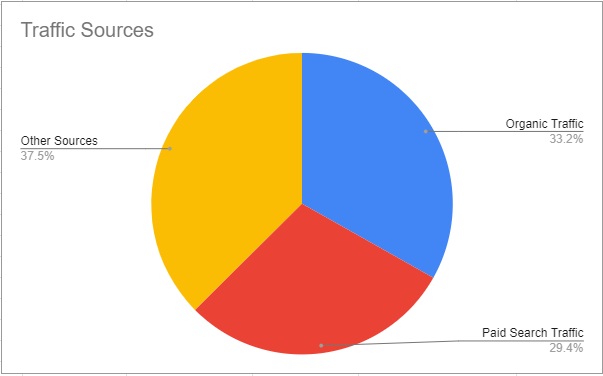
3: 86% of the companies surveyed receive more traffic from Organic compared to Incoming Paid Ads. The 14% who receive more traffic through Paid Ads tend to be the larger e-commerce companies.
4: SEO also fairs well in generating sales, although this is one aspect where Paid Ads are more effective. 45% of Sales can be attributed to Organic sources and 55% of Sales to Paid Advertising – this is not surprising as Paid Advertising is much more targeted and designed specifically to drive sales.
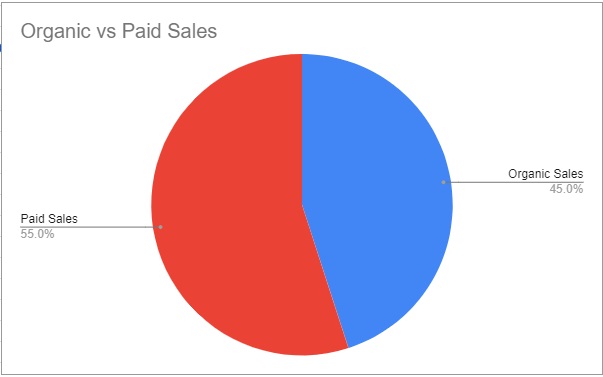
5: When it comes to other Key Events Organic Sources reign supreme generating 78.35% of these with Paid Ads generating the remaining 21.65%.
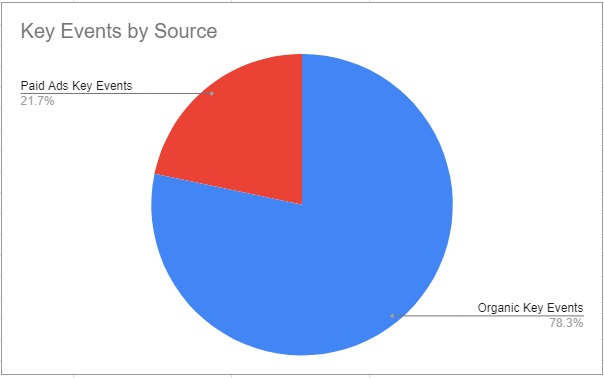
6: The companies that are the most successful are the ones that make effective use of both SEO and Inbound Ads, there is a strong correlation between SEO and Paid Ads in the buyer’s journey. The Paid Ads often generate the initial site visit during the awareness stage and the SEO is responsible for subsequent visits during the research and decision-making stages.
Let’s look at some real figures of a few random companies we work with and how SEO has improved their position on Google and brought them more traffic. The following data is a 28 day period compared to the same 28 days a year ago. As SEO is a longer-term tactic I’m not fond of month-to-month comparisons, comparing year to year is more accurate and takes seasonalities into account.
Company 1:
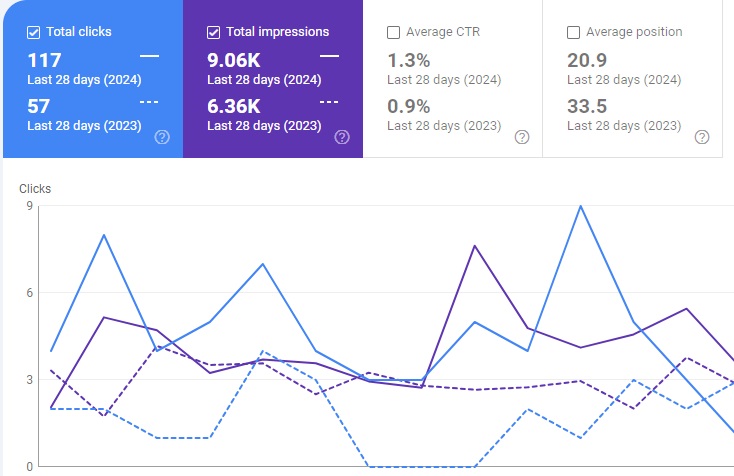
This company experienced a 105% increase in Google Organic traffic driven mostly by an average position improvement of 12 in the Google Search Results and a 45% improvement in CTR resulting in a growth of 42% in Impressions. This improvement is driven primarily by On-Page SEO, good quality Content and ensuring that the website provides a good user experience.
Company 2:

This company has also experienced massive growth in Google Organic traffic of 83% driven by a 218% increase in Impressions, this tells me that this site is benefitting from not only improvements to existing keywords but new content and other SEO efforts are starting to attract a lot of attention around new keywords.
Many of these new keywords may still have fairly low rankings which would explain why the Average position and CTR have declined even though Impressions and Clicks have increased dramatically. The mathematics involved can make the Average Position and CTR appear to be worse than the year before even though the website is improving and attracting more Clicks.
Company 3:
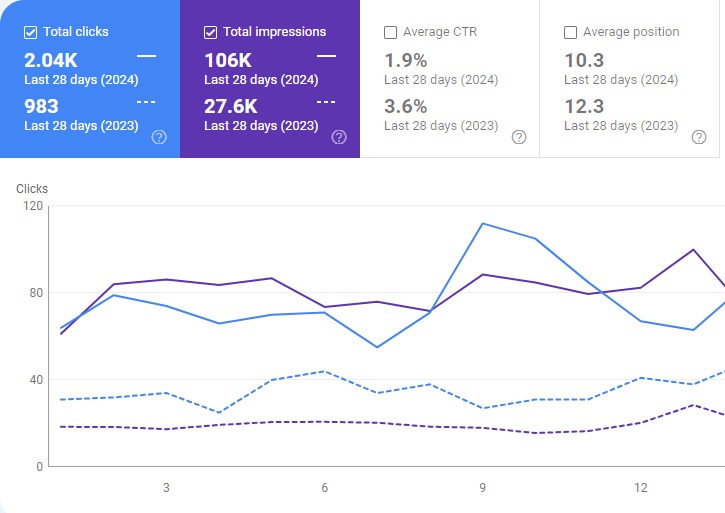
This company is also experiencing strong Organic growth due to new keywords starting to rank and an improvement in the rankings for existing keywords resulting in a massive growth of 284% in Impressions and a corresponding 107% growth in Clicks.
Conclusion
SEO remains an excellent source of high-quality website visitors. I could have dug deeper into Bounce Rates and other Engagement statistics to further prove that SEO is not only alive and well, but I believe the fact that SEO still generates the Lion’s share of website traffic and is responsible for 45% of Sales and 78% of other Key Events is sufficient. SEO remains a highly effective tool in attracting website visitors and converting them into paying customers.
And don’t forget SEO builds up momentum, unlike Paid Ads that stop generating traffic the moment you stop paying for them, SEO continues generating quality website traffic for years to come.
Can you afford to not invest in SEO? probably not. Contact Us today for all your SEO Requirements.

